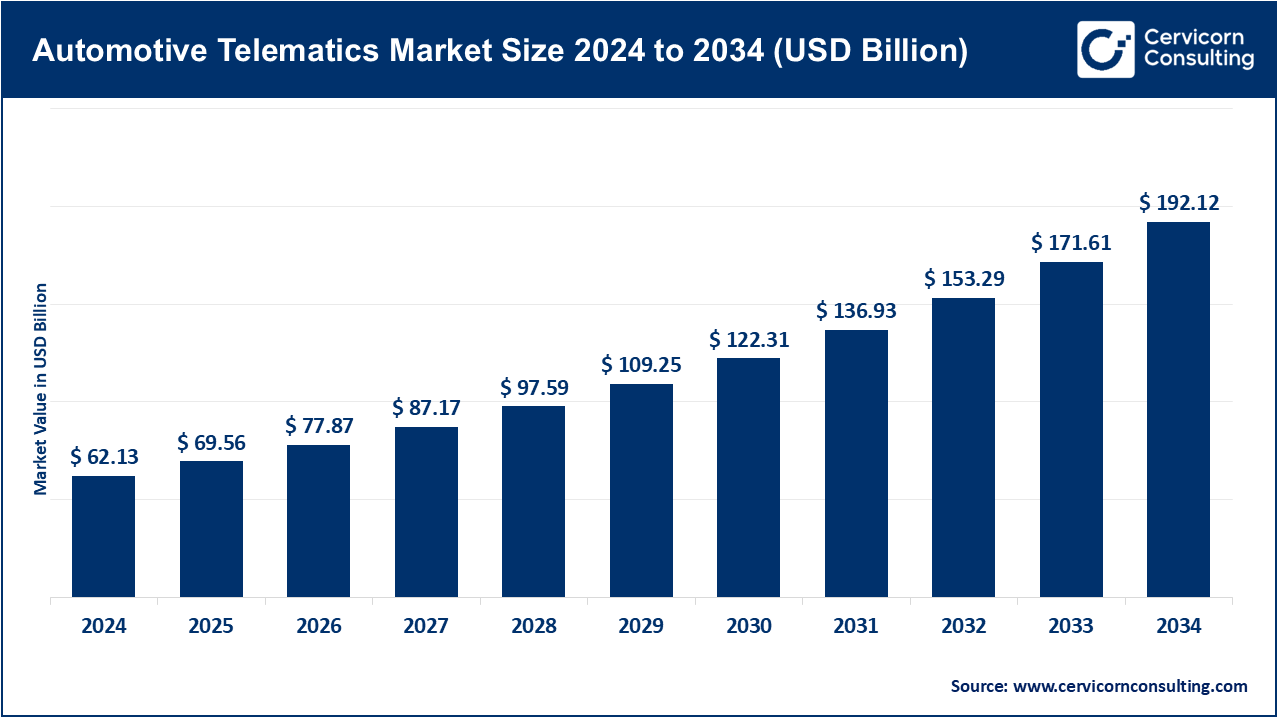Automotive Telematics Market Overview
The global automotive telematics market was valued at approximately USD 62.13 billion in 2024 and is projected to reach around USD 192.12 billion by 2034, growing at a CAGR of 15.2% from 2025 to 2034.
This market is expanding rapidly due to the growing adoption of connectivity solutions, IoT devices, and vehicle-to-everything (V2X) technologies. Automotive telematics includes vehicle tracking, navigation, fleet management, safety, and infotainment systems, enabling real-time communication between vehicles, infrastructure, and users. Growth is being driven by increasing consumer demand for enhanced safety and convenience features, alongside regulatory support for connected vehicle technologies.
Get a Free Sample: https://www.cervicornconsulting.com/sample/2697
Key Market Trends
Advanced Connected Vehicle Technologies:
Integration of 5G networks and IoT devices enhances real-time data exchange. Modern telematics systems now offer over-the-air (OTA) updates, predictive maintenance, and emergency response functionalities.
Electric Vehicle (EV) Telematics:
The rise in EV adoption is boosting demand for telematics solutions that monitor battery health, charging infrastructure, and route optimization. Smart charging telematics, for example, enable efficient energy usage and support fleet electrification strategies.
Data-Driven Fleet Management:
AI and analytics are increasingly used in fleet telematics to optimize routes, reduce fuel consumption, and enhance driver safety. Commercial logistics companies leverage telematics dashboards for predictive insights and operational efficiency.
Regulatory Compliance and Safety Standards:
Governments are mandating connected vehicle technologies to improve safety and ensure environmental compliance. Regulations in the EU and U.S., such as Electronic Logging Devices (ELDs) and driver monitoring systems, are accelerating telematics adoption.
Consumer Preference for Personalized Experiences:
Rising interest in infotainment integration, real-time traffic updates, and usage-based insurance (UBI) is driving demand for telematics-enabled applications that track driving behavior and offer personalized services.
Market Drivers
Growing Demand for Connected Vehicles:
Consumers are increasingly seeking advanced safety and convenience features, boosting telematics adoption.
Government Initiatives:
EV incentives and vehicle safety regulations support telematics integration. For example, the U.S. ELD mandate has accelerated telematics use in commercial fleets.
Technological Advancements:
5G, AI, and IoT enable smarter telematics solutions with predictive maintenance and real-time monitoring, reducing operational costs for fleet operators.
Changing Consumer Preferences:
Shifts toward subscription-based mobility, telematics-driven insurance, and smart navigation solutions are driving market growth.
Impact of Trends and Drivers
By Segment: Passenger vehicles and commercial fleets are adopting tailored telematics solutions, with EV-focused telematics growing fastest.
By Region: North America and Europe lead due to regulatory support, while Asia-Pacific is expanding rapidly, driven by EV adoption and urban fleet growth.
By Application: Fleet management, insurance, vehicle tracking, and predictive maintenance are seeing increased penetration across industries.
Challenges & Opportunities
Challenges: High initial investment, data privacy concerns, and lack of standardized telematics protocols.
Opportunities: Integration with autonomous vehicles, smart city infrastructure, and usage-based insurance models are opening new revenue streams.
Future Outlook
The automotive telematics market is set for strong growth, shaped by AI-driven predictive analytics, 5G connectivity, and EV telematics. As vehicles become more connected and intelligent, telematics will play a pivotal role in the future of mobility.
For more detailed insights, contact us: Contact Us
Read Report: Plastic Compounding Market Trends, Drivers, and Emerging Opportunities from 2024 to 2034
